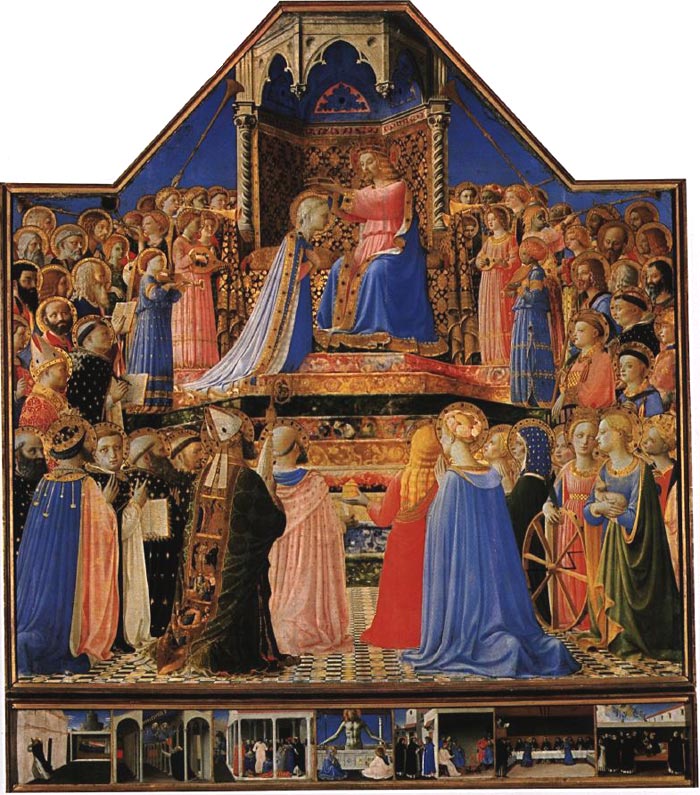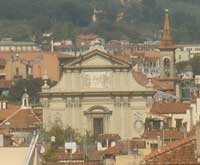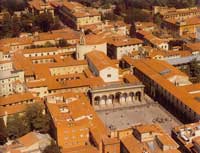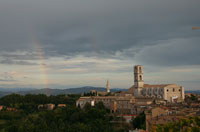| |
|
Between the years 1420 and 1422, Fra Angelico became a Dominican friar and resided in the priory of San Domenico at Fiesole, there taking the name of Fra Giovanni da Fiesole. At Fiesole he was probably influenced by the teachings of Giovanni Dominici, the militant leader of the reformed Dominicans. The writings of Dominici defended traditional spirituality against the onslaught of humanism.
Angelico was also influenced by his fellow friar St. Antoninus Pierozzi, who became the archbishop of Florence when Fra Angelico refused the post and who may have consolidated Angelico’s faith. It is believed that Antoninus also may have inspired some of Angelico’s compositions.
According to the painter and biographer Giorgio Vasari, Angelico was trained by the greatest painter and miniaturist of the Gothic tradition, Lorenzo Monaco, whose influence may be seen in the clear, painstaking delicacy of execution and the vibrant luminosity that seem to spiritualize the figures in Angelico’s paintings. These qualities are notably apparent in two small altarpieces, Madonna of the Star and The Annunciation Lorenzo Monaco was the outstanding painter in Florence during the first quarter of the fifteenth century—before the appearance of Masaccio, Masolino, and Fra Angelico—and the undisputed master of the so-called International Gothic Style. These four pictures of Old Testament patriarchs rank among Lorenzo's masterpieces. While the brilliant coloring and refined treatment of details recall his work as a miniaturist, the solid treatment of forms relates them to contemporary Florentine sculpture—especially that of Ghiberti and Nanni di Banco.
Angelico’s Deposition for Santa Trinità in Florence was once attributed to Monaco, who had begun it before he died in 1425. Monaco had divided it into a triptych and executed the pinnacles. Angelico, however, made it a unified altarpiece with a vast landscape dominated by a varicoloured hill town. It is perhaps an imaginative evocation of Cortona, where Fra Angelico spent some time and where some of his important works are to be found. Against that background are sharply outlined human figures in interconnected groups; their features are so delicately traced that attempts have been made to identify them as portraits. These arrangements of figures attest to Angelico’s deep knowledge of the formalism that characterized the art of the early Renaissance.
Two strands were interwoven in Angelico’s life at Fiesole: the pious life of a friar and continuous activity as a painter. Vasari described him as “saintly and excellent,” and, not long after his death, he was called angelico (“angelic”) because of his moral virtues. This subsequently became the name by which he is best known, often preceded by the word beato (“blessed”).
Angelico knew and followed closely the new artistic trends of his time, above all the representation of space by means of perspective. In works such as the large Last Judgment and The Coronation of the Virgin, for example, the human figures receding toward the rear themselves create a feeling of space similar to that in the paintings of Angelico’s great Florentine contemporary Masaccio. [1]
|
The Coronation of the Virgin is a painted retable, perhaps commissioned by the Gaddi family, for one of the altars of the monastery of San Domenico in Fiesole (near Florence), where the artist later served as prior. The studied perspective and the physicality of the figures attest to the influence of Masaccio on the young Fra Angelico.
Based on apocryphal texts, the Coronation theme was widely disseminated in the 13th century through Jacobus De Voragine's Legenda Aurea (Golden Legend). The episode follows the Assumption and describes the celestial welcome of the Virgin by Christ, who lifts her above the multitude of the blessed. By way of nine marble steps of various colors, the Virgin climbs to Christ's throne, where a place to His right has been reserved for her. Kneeling with her head bowed, the Virgin receives the crown from the hands of her Son in glory. They are surrounded by the heavenly host, composed of angel musicians and saints, some of whose names appear engraved on their respective haloes; others are identifiable by their attributes. In the foreground, from left to right: St. Louis of France with his fleur-de-lys crown; Mary Magdalene, in red with her hair loose and holding a vase of perfume; St. Catherine of Alexandria with the wheel of her martyrdom; and St. Agnes, holding a lamb to her breast.
The Coronation of the Virgin
Several Dominicans, the patrons of this work, are recognizable by their white robes and black mantles. St. Dominic appears in profile; he holds a lily and above his head shines a red star. The martyred St. Peter is depicted with a bleeding wound on his head. The theologian St. Thomas Aquinas is also present, holding his writings and pointing to the scene.
Fra Angelico and his times
The composition is based on the pyramidal structure of the steps and the figures of the Virgin and Christ. The space has been determined according to the laws of linear perspective; these define the angle of the paving stones, which converge at a point above the vase of Mary Magdalene. The space is coherent, each figure placed in such a way that all can be seen. The sculptural volume of the bodies, whose monumentality is accentuated by the low point of view, is reminiscent of the works of Masaccio, which Fra Angelico had the opportunity to contemplate in Florence. Unlike Masaccio, however, Fra Angelico rejected idealized architecture in favor of an aedicula with Gothic forms. The delicate modeling of the faces was inspired by that of Gentile da Fabriano and the color scheme by the palette of Lorenzo Monaco.
St Nicholas of Bari is shown kneeling in the foreground of The Coronation of the Virgin with his episcopal mitre and crook. St Nicholas's cope shows several scenes from the Passion, including the Betrayal, Mocking, and Flagellation. To his left are St Anthony and St Francis of Assisi.
|
|
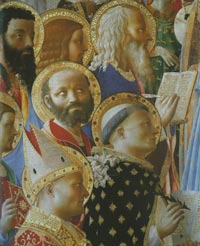
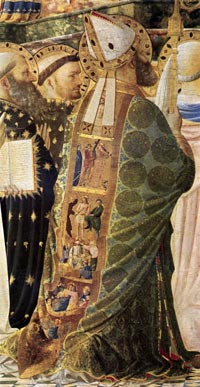
Coronation of the Virgin (details), Musée du Louvre, Paris. St Nicholas's cope shows several scenes from the Passion, including the Betrayal, Mocking, and Flagellation.
|
| |
|
|
|
|
| |
|
Predella paintings |
|
|
| There are many legends of Saint Dominic compiled by Gerard de Frachet from the Book of Epilogues of Brother Bartholomew of Trent, one of the Saint's first companions, and from the History of the Foundation of the Order, composed by Blessed Jordan of Saxony, and dedicated by him to his 'sons by grace and joint heirs to glory'. The Legend dates between 1255 and 1257.
The first representations of these legends we find on the sarcophagus of Saint Dominic in the basilica of Saint Dominic in Bologna by the sculptor Nicola Pisano (ca 1220-after 1278). Fra Angelico depicted the same events in 1434-1435, on the predella of the Pala du Louvre. |

|
On the predella are scenes referring to episodes in the life of the order's founder: The Dream of Innocent III, Saints Peter and Paul Appearing to St. Dominic, St. Dominic Restoring Napoleone Orsini, Christ in the Tomb, The Dispute of St. Dominic and the Miracle of the Book, St. Dominic and his Companions Fed by Angels, and The Death of St. Dominic.
|
The Dream of Innocent III
|
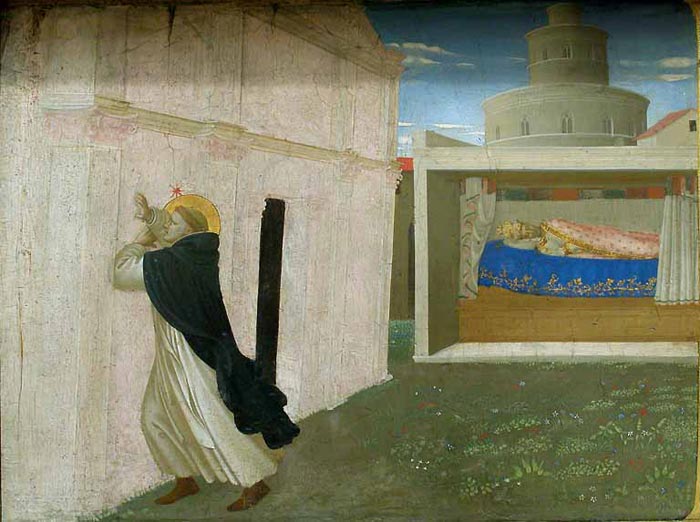 |
Fra Angelico, Coronation of the Virgin, predella painting, The Dream of Innocent III, 1434-35, tempera on panel, 213 x 211 cm, Musée du Louvre, Paris
|
Saint Dominic asks Pope Innocent III to approve the Order; the Pope dreams of the Saint supporting the basilica of the Lateran; the Pope approves the foundation of the Order on 22 December 1216.
The meeting with the Saints Peter and Paul. Once, while praying in the old Saint Peter's Basilica in Rome (1217), Saint Dominic saw a vision. The Apostle Peter handed him a staff, and the Apostle Paul handed him a book. Together, they spoke to him, saying, "Go and preach, because you have been chosen by God for this work." Immediately, it seemed to Dominic that he saw all his children preaching two by two throughout the world. From then on, Saint Dominic was often seen on the road carrying a walking stick and the Epistles of Saint Paul. He also carried the Gospel of Saint Matthew, and could recite these Scriptures by heart.
|
St. Dominic Restoring Napoleone Orsini
|
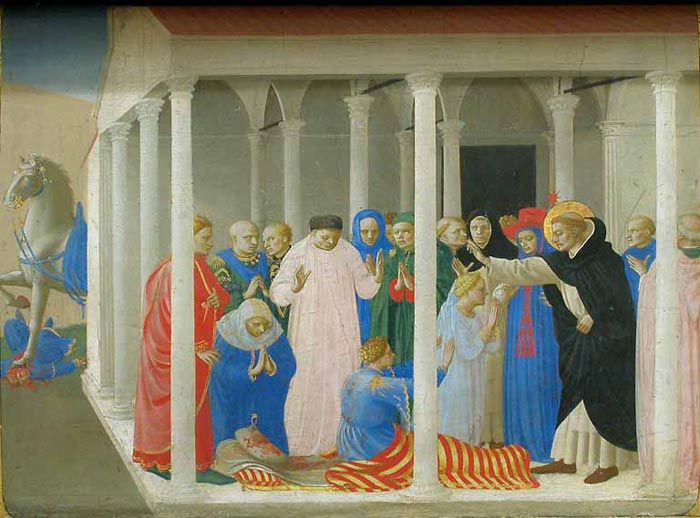 |
Fra Angelico, Coronation of the Virgin, predella painting, St. Dominic Restoring Napoleone Orsini, 1434-35, tempera on panel, 213 x 211 cm, Musée du Louvre, Paris
|
Saint Dominic revives prince Napoleone Rossini (1257-1298) after his fatal fall from his horse.
|
Christ in the Tomb
|
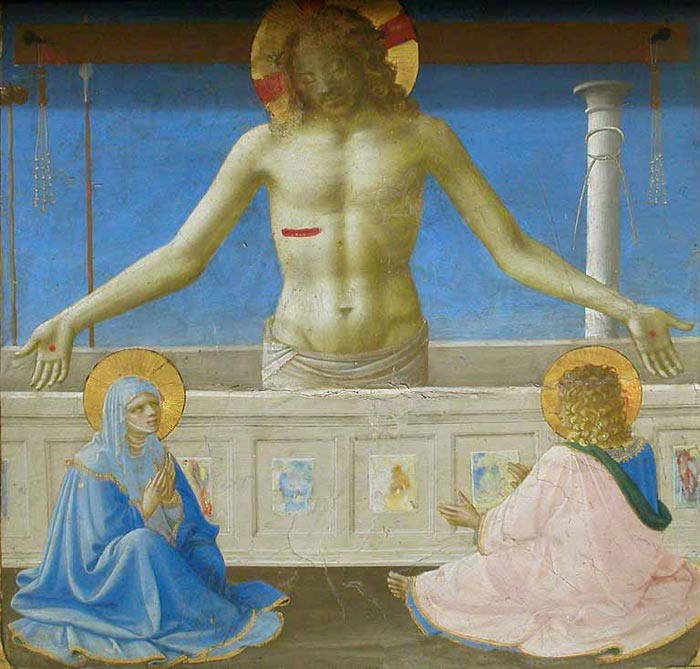 |
Fra Angelico, Coronation of the Virgin, predella painting, Christ in the Tomb, 1434-35, tempera on panel, 213 x 211 cm, Musée du Louvre, Paris
|
The entombment of Christ with the Virgin and Saint John.
|
The Dispute of St. Dominic and the Miracle of the Book
|
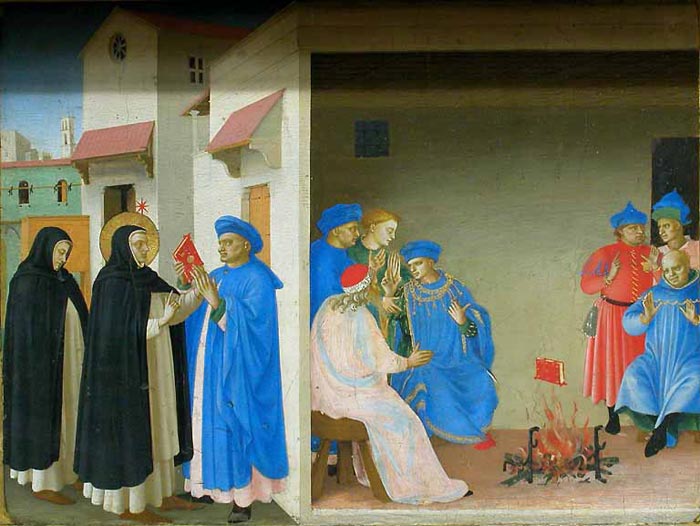 |
Fra Angelico, Coronation of the Virgin, predella painting, The Dispute of St. Dominic and the Miracle of the Book, 1434-35, tempera on panel, 213 x 211 cm, Musée du Louvre, Paris
|
The dispute of Saint Dominic with the Albigensians and the miracle of the document with his text of his refutations in Fanjeaux. Saint Dominic tells Pierre des Vaux-de-Cernai, that he the little document with his opinion about the doctrine of theAlbigensians had to drop in the fire by order of the members of the jury. It remained not burned down, not even after three times."
After M.-H.Vicaire: Dominicus, Dutch translation. 1957, p.89.
|
St. Dominic and his Companions Fed by Angels
|
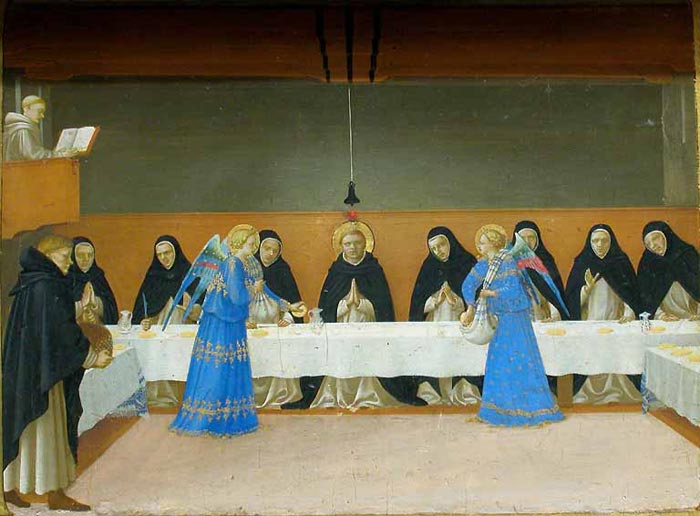 |
Fra Angelico, Coronation of the Virgin, predella painting, St. Dominic and his Companions Fed by Angels, 1434-35, tempera on panel, 213 x 211 cm, Musée du Louvre, Paris
|
The community at San Sisto (Rome) had grown very numerous. One day, Dominic was informed by the procurator that their begging had produced almost no food. He ordered the brethren, nevertheless, to gather at table for their meal. He then prayed and suddenly two young men or angels, looking mysteriously alike, came into the refectory to dispense a portion of bread and wine to each friar. The same procurator told of a similar miracle on another occasion.
|
The Death of St. Dominic
|
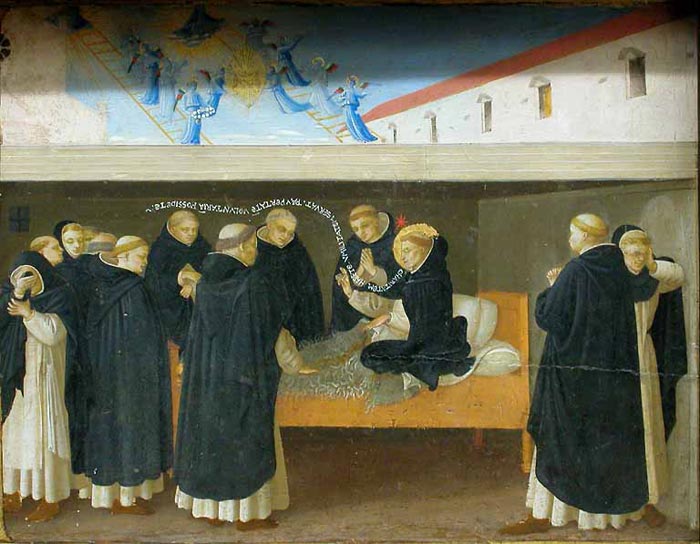 |
Fra Angelico, Coronation of the Virgin, predella painting, The Death of St. Dominic, 1434-35, tempera on panel, 213 x 211 cm, Musée du Louvre, Paris
|
The death of Saint Dominic on 6 August 1221.
|

Hierarchies of Vision: Fra Angelico's Coronation of the Virgin from San Domenico, Fiesole Oxford Art J (2004) 27(2): 137-153
Giorgio Vasari | Lives of the Most Eminent Painters Sculptors and Architects, Fra Angelico | Detailed biography of the artist
The Coronation of the Virgin by Guido di Pietro known as FRA ANGELICO | Paintings Louvre Museum | www.louvre.fr

[1] Encyclopedia Britannica complete article on Fra Angelico | The full version of the article is available only if you follow this link.
Fra Angelico was born in the town of Vicchio di Mugello, northeast of Florence, at the end of the fourteenth century. His birth date, which Vasari reports as 1387 and which has been restated by some scholars as about 1400, was probably about 1390-1395, since in 1417 Guido di Pietro, still a layman, was already documented as a painter, and the following year he was paid for the prestigious commission of part of an altarpiece for the church of Santo Stefano al Ponte. Just before 1423, Guido donned the habit of the Domenican friars in the convent of San Domenico at Fiesole, taking the name Fra Giovanni. The appellation "Fra Angelico" became current only in the nineteenth century; it derives from an abbreviation of the epithet "pictor angelicus," which was first applied to him in early Dominican sources and has been common since Vasari's time.°
The artist's early production, for which no certain points of reference survive, is still the subject of discussion. Recent criticism tends to move the date of the triptych of Saint Peter Martyr (Florence, Museo di San Marco) back to about 1425-1427, although it was not paid for until 1429. An even earlier date, about 1422-1423, should be assigned to the altarpiece for the high altar of San Domenico di Fiesole (the main panels are still in the church today). Several other paintings have been grouped with this work, and if they are indeed by Angelico, they show that his training was influenced not so much by the late Gothic tradition of Lorenzo Monaco, as had been thought, but by the presence in Florence of Gentile da Fabriano (from 1420 to c. 1425-1426) and by the artistic innovations introduced by Ghiberti, Masolino, and Masaccio.
By the 1430s Fra Angelico was already one of the leading artists in Florence, and a series of documented works allows us to reconstruct his development more clearly: the Deposition painted for the Strozzi chapel in the church of Santa Trinità by 1432 (Museo di San Marco, Florence); the slightly later Coronation of the Virgin, painted for San Domenico by 1435 and today in the Musée du Louvre; the Tabernacle of the Linaioli (Museo di San Marco), commissioned in 1433 and finished in 1436; and the painted reliquary panels executed for Fra Giovanni Masi (three in Florence in the Museo di San Marco and one in the Isabella Stewart Gardner Museum, Boston), executed between the end of the 1420s and the beginning of the following decade, but certainly complete before 1434. Angelico expressed profound human sentiments in his figures; he modeled with light and intense, brilliant colors, as opposed to Masaccesque chiaroscuro. His mastery of Brunelleschian perspective permitted daringly innovative compositions with convincing spatial effects in architectural settings.
Fra Angelico's extraordinary realism is evidenced also by such works as the Lamentation for Santa Maria della Croce al Tempio (1436) and the more or less contemporary Annalena altarpiece (both in the Museo di San Marco), where lively, statuesque figures are arranged in open, balanced compositions bathed in an atmosphere of luminous color.
In 1438 renovation of the Dominican convent and church of San Marco began, commissioned by Cosimo de' Medici and directed by Michelozzo; the new church was consecrated by Pope Eugenius IV on 6 January 1443. Fra Angelico, who had by then moved to the order's headquarters in Florence, was entrusted with the execution of an altarpiece for the high altar (the majestic Sacra Conversazione, now also in the Museo di San Marco) and the decoration of various areas of the convent. From the vast Crucifixion in the chapter house to the small frescoes in the cells, rich narrative is restrained in favor of a sublime spiritual and poetic message, dominated by an analytical vision that owes much to contemporary Flemish models.
In 1445 Fra Angelico was in Rome at the behest of Pope Eugenius IV, and in 1446 in Orvieto, where he began to fresco the vaults of the chapel of Saint Brizio in the duomo, finished several decades later by Signorelli. The following year he may have been in Perugia to paint the San Domenico polyptych (now divided between the Galleria Nazionale in Perugia and the Pinacoteca Vaticana), and then he was back in Rome to paint scenes from the lives of Saints Stephen and Lawrence in the private chapel of Pope Nicholas V in the Vatican. From 1450 to 1452 he was prior of the convent in Fiesole, and this is probably when he painted the scenes from the life of Christ on the doors of the silver chest for Santissima Annunziata (Museo di San Marco). In 1454 he was again in Perugia, and then in Rome, where he died on 18 February 1455. [This is the artist's biography published, or to be published, in the NGA Systematic Catalogue]
[°] In the Theotocon of Fra Domenico di Giovanni da Corella (manuscript in the Biblioteca Nazionale in Florence), written in the second half of the fifteenth century, he is called "angelicus pictor" for the first time; see Ordinis praedicatorum... 1960, 20.
National Gallery of Art, Washington, DC | www.nga.gov
|
|
|
| |
|

Tuscany is one of the most popular tourist destinations in the world. Known for its enchanting landscapes, its fantastic and genuine food and beautiful towns as Florence, Pisa, Lucca and Siena. Tuscany is much more! Spas and thermal baths, natural parks and caves, traditional festivals & tastings. Podere Santa Pia is located in the heart of the Valle d'Ombrone, and one can easily reach some of the most beautiful attractions of Tuscany, such as Montalcino, Pienza, Montepulciano and San Quirico d'Orcia, famous for their artistic heritage, wine, olive oil production and gastronomic traditions. It is the ideal place to pass a very relaxing holiday in contemplation of nature, with the advantage of tasting the most typical dishes of Tuscan cuisine and its best wines. Not far from Cinigiano and clearly visible from Podere Santa Pia, is the famous Castle of Poggio alle Mura, also known as Villa Banfi and home to one of the most popular producers of Brunello di Montalcino D.O.C.G. wine. Set in 7100 hectares of land in the Montalcino area, Castello Banfi il Borgo is one of the most important wine producers in Tuscany. This is the land where the DOC wines Montecucco and Brunello are produced. So, the surrounding countryside is the ideal area for an uncommon wine tour, visiting small farms producing wine and excellent extra virgin olive oil.
If you want to spend an unforgettable holiday at Podere Santa Pia, visit our special offers page or contact us.
|
| |
|
|
|
|
 |
|

|
Podere Santa Pia, mystic holiday home in the heart of the Tuscan Maremma
|
|
Casa Vacanze Podere Santa Pia, Castiglioncello Bandini, Toscane
|
|
Colline sotto Podere Santa Pia con ampia vista sulla Maremma Grossetana
|
 |
|
 |
|
 |
A beautiful summer morning by the pool
|
|
Reflections on the private swimming pool at Podere Santa Pia
|
|
Evenings around the pool in Tuscany offer a totally different quality of light and amazing colors
|
|
|
|
|
|
The façade and the bell tower of
San Marco in Florence
|
|
Piazza della Santissima Annunziata
in Florence
|
|
|
Fra Angelico in Palazzo Strozzi en Museo San Marco
Beato Angelico a Palazzo Strozzi e Museo di San Marco
26
September - 25 Januari 2026
The exhibition Beato Angelico at Palazzo Strozzi and the Museo San Marco explores the work, development, and influence of Beato Angelico's art, as well as his relationships with painters such as Lorenzo Monaco, Masaccio, Filippo Lippi, and sculptors like Lorenzo Ghiberti, Michelozzo, and Luca della Robbia.
It is the first major exhibition in Florence dedicated to the artist exactly seventy years after the 1955 monograph.
|
 |
|
 |
|
 |
Palazzo Strozzi, Firenze
|
|
Beato Angelico, mostra Palazzo Strozzi and Museo di San Marco, Firenze, 2025
|
|
Museo di San Marco, veduta posteriore
|
The monastery of San Domenico in Fiesole
|
|
|
The Convent of San Domenico, a Dominican convent in Fiesole, was founded in 1406 and completed in 1435 on the initiative of Giovanni Dominici and the bishop of Fiesole, Jacopo Altoviti, both of them monks at the Basilica of Santa Maria Novella in Florence.
Being already an artist, Fra Angelico entered the monastery of San Domenico a Fiesole and became a prior in 1449.
His first famous works were Diurno domenicale 3 (Florence, Biblioteca Laurenziana); Trittico di San Pietro martire (Florence, Mus. di San Marco); Madonna con il Bambino e angeli (Franckfurt, Stadelsches Kunstinstitut), in which could be seen the influence of Lorenzo Monaco and Gentile da Fabriano. But very soon (before 1430) Angelico had got very much interest in work of Masaccio: Madonna e quattro santi (Parma, Pict. Gall.); Annunciazione (Madrid, Mus.del Prado).
Later he develops the inventions of light and color spreading and creates the new conception of space and proportions: Crocifissione (Fiesole, monastery of San Domenico); Annunciazione e Adorazione dei Magi, Giudizio Universale, Messale 558 (Mus. di San Marco); Incoronazione di Maria (Florence, Gall degli Uffizi)..
San Domenico di Fiesole can be reached by walking down the road toward Florence. Nearby is the Badia Fiesolana, Fiesole's ancient cathedral built in 1028, with its original Romanesque facade. |
|
|
